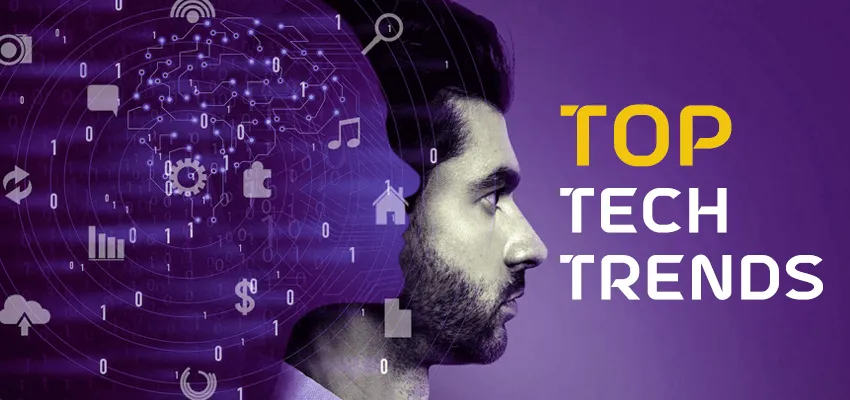In 2025, technology is no longer just a tool—it’s the backbone of global progress. Every sector, from healthcare to finance to education, is rapidly evolving with digital innovation. Businesses are transforming how they operate, and individuals are changing how they live and work. To stay competitive and future-ready, understanding emerging technology trends is not optional it’s essential.
From AI agents and edge computing to quantum breakthroughs and sustainable infrastructure, the tech world is shifting faster than ever. This article explores the top 10 technology trends defining the digital age, grounded in credible insights and real-world impact. Whether you’re an entrepreneur, developer, investor, or curious learner, this guide offers the clarity you need to adapt and thrive in a rapidly evolving world.
1. Agentic AI and Autonomous Intelligence
Agentic AI refers to AI systems capable of acting autonomously, learning from data, and making decisions with minimal human input. Unlike traditional AI that relies on commands, these agents can plan, execute, and adapt strategies independently. In 2025, industries are leveraging these systems for customer support, supply chain optimization, and enterprise automation. They improve efficiency, reduce errors, and open new possibilities in process automation. Businesses using agentic AI can expect faster workflows and smarter decision-making.
2. 5G and the Path to 6G
5G technology is now mainstream, enabling ultra-fast, low-latency networks across mobile and IoT devices. It allows for real-time remote surgeries, autonomous vehicles, and immersive AR/VR applications. As we transition toward 6G, which is expected to emerge commercially after 2030, researchers focus on enhancing bandwidth, satellite connectivity, and AI-driven networking. In 2025, 5G-Advanced is the bridge, offering capabilities like machine-type communication, network slicing, and improved energy efficiency. This evolution supports everything from smart cities to industrial automation.
3. Edge Computing and Edge AI
Edge computing brings processing power closer to the data source—your devices, sensors, or factory floors—rather than sending data back to centralized cloud servers. This results in lower latency, improved privacy, and faster response times. Paired with Edge AI, devices can now run intelligent algorithms locally, without relying on continuous internet access. Applications include autonomous vehicles, predictive maintenance in manufacturing, and real-time analytics in healthcare. Edge technology is redefining how companies manage data and make decisions.
4. Quantum and Neuromorphic Computing
Quantum computing is reaching commercial viability, promising exponential processing power for problems too complex for classical computers. It is particularly impactful in cryptography, drug discovery, and financial modeling. Neuromorphic computing, on the other hand, mimics the human brain’s neural architecture to deliver energy-efficient, parallel processing. Together, they are pushing the boundaries of what machines can learn, predict, and solve. In 2025, enterprises are exploring these technologies for advanced simulations, optimization tasks, and next-gen AI systems.
5. Extended Reality (XR) and Spatial Computing
Extended Reality (XR), encompassing augmented, virtual, and mixed reality, is expanding beyond entertainment. Companies are using XR for employee training, design collaboration, and remote fieldwork. Spatial computing further enhances XR by mapping the physical environment and blending it with digital content. In industries like architecture, healthcare, and retail, XR is creating immersive experiences that improve productivity, engagement, and decision-making. With lightweight headsets and AR glasses becoming more accessible, XR adoption is set to accelerate.
6. Blockchain Beyond Cryptocurrency
While cryptocurrency markets have stabilized, blockchain technology continues to innovate. In 2025, its impact is seen in supply chain transparency, digital identity, contract automation, and secure data exchange. Enterprises are adopting Blockchain-as-a-Service platforms to integrate decentralized ledgers without the overhead of infrastructure management. Tokenization of real-world assets, from real estate to intellectual property, is also on the rise. Blockchain offers a secure, transparent framework for trust in digital ecosystems beyond finance.
7. Cybersecurity Mesh and Post-Quantum Security
Cybersecurity mesh architecture (CSMA) provides a flexible, modular approach to securing digital infrastructure across distributed environments. With growing cloud adoption and remote work, centralized security is no longer sufficient. CSMA ensures consistent protection for users and devices, regardless of location. Additionally, with quantum computers threatening traditional encryption, organizations are preparing with post-quantum cryptographic standards. In 2025, cybersecurity is not just about firewalls—it’s about adaptive, intelligent defense systems that evolve with emerging threats.
8. Sustainable Technology and Green Innovation
As climate concerns grow, sustainability is a core part of tech strategy. Companies are designing greener data centers, optimizing AI models for energy efficiency, and investing in carbon-reduction technologies. From smart grids to clean computing, green tech innovations are helping organizations meet environmental goals while reducing costs. Technologies such as AI-driven energy management, biodegradable electronics, and solar-powered IoT devices are becoming mainstream. Sustainability is not just a value—it’s a competitive advantage.
9. Digital Twins and Predictive Simulation
Digital twins are virtual replicas of physical assets, processes, or systems, updated in real time. By simulating operations and predicting failures before they happen, businesses can reduce downtime and improve maintenance efficiency. In manufacturing, digital twins optimize factory output. In construction, they model structural integrity. In healthcare, they simulate patient responses to treatments. This trend is driving better planning, decision-making, and cost control across a wide range of sectors.
10. Robotics and Autonomous Systems
Automation through robotics is transforming logistics, agriculture, and even healthcare. Drones are monitoring crops, robots are delivering packages, and AI-powered machines are performing surgeries. Autonomous systems rely on a fusion of sensors, AI, and connectivity to operate in dynamic environments without human control. In warehouses, robotic fleets optimize inventory management. In urban mobility, driverless taxis are gaining regulatory approval. These innovations reduce human error and increase efficiency, safety, and speed across operations.
Read Also: Selenium Automation: Complete Guide for Efficient Web Testing in 2025
Conclusion
Technology in 2025 is defined by convergence, intelligence, and impact. As emerging trends like agentic AI, 5G, edge computing, and quantum systems advance, they are no longer isolated innovations they are interconnected forces transforming our world. Businesses must embrace change, not resist it. Those who align with these trends will unlock new efficiencies, empower their workforce, and create lasting value. Equally important is the ethical and sustainable application of these technologies.
As digital twins simulate real-world scenarios, XR reshapes how we interact, and blockchain secures our data, we’re entering a world that is smarter, safer, and more immersive. Cybersecurity and sustainability are no longer side concerns they’re pillars of technological progress. The future belongs to those who adapt and innovate responsibly. Whether you’re a tech leader, strategist, or learner, staying ahead of these trends ensures relevance and resilience in an increasingly complex digital landscape.
FAQs (People Also Ask)
1. What are the top technology trends in 2025?
Key trends include agentic AI, 5G and 6G development, edge computing, quantum computing, XR, blockchain, cybersecurity mesh, digital twins, robotics, and sustainable tech.
2. Why is edge computing important in 2025?
Edge computing enables faster, more secure processing of data close to its source, improving performance in real-time applications like smart cities and autonomous vehicles.
3. How does quantum computing affect everyday industries?
Quantum computing can revolutionize sectors like healthcare, finance, and logistics by solving complex problems faster than traditional computers.
4. What role does blockchain play beyond cryptocurrency?
Blockchain supports secure, transparent digital operations in areas like identity verification, smart contracts, and supply chain tracking.
5. How are businesses using digital twins?
Businesses use digital twins to monitor systems in real time, predict outcomes, reduce maintenance costs, and improve operational efficiency.





